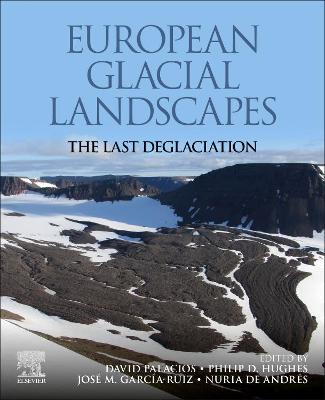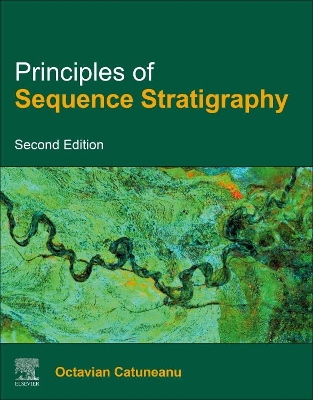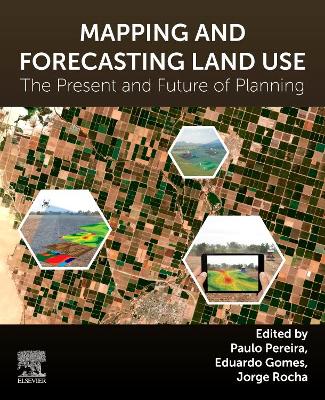European Glacial Landscapes
 -10%
portes grátis
-10%
portes grátis
European Glacial Landscapes
The Last Deglaciation
Hughes, Philip D.; Palacios, David; de Andres, Nuria; Garcia-Ruiz, Jose M.
Elsevier - Health Sciences Division
09/2022
644
Mole
Inglês
9780323918992
15 a 20 dias
450
Descrição não disponível.
PART I. Introduction
1. Introduction
2. The Terminations of the Glacial Cycles.
3. Previous synthesis of Last Deglaciation in Europe
PART II. Climate changes during the Last Deglaciation in the Eastern North Atlantic region
4. Introduction
5. The Heinrich-1 Stadial
6. The Bolling-Allerod Interstadial
7. The Younger Dryas Stadial
PART III. The European glacial landforms during main deglaciation (18.9-14.6 ka)
8. Concept and global context of the glacial landforms from deglaciation
SECTION 1. European regions that were covered by the European Ice Sheet Complex (EISC)
9. European Ice Sheet Complex evolution during main deglaciation (18.9-14.6 ka)
10. Fennoscandia: glacial landforms during deglaciation (18.9-14.6 ka)
11. Northern Central Europe: glacial landforms during deglaciation (18.9-14.6 ka)
12. European Russia: glacial landforms during deglaciation (18.9-14.6 ka)
13. The Eurasian Arctic: Glacial landforms during main deglaciation (18.9-14.6 ka)
14. The North Sea and Mid Norwegian Continental Margin: glacial landforms during deglaciation, the Bolling-Allerod Interstadial and the Younger Dryas.
15. Britain and Ireland: glacial landforms during deglaciation (18.9-14.6 ka).
SECTION 2. European regions that were not covered by the EISC
16. The Polar Ural Mountains: Deglaciation history.
17. Iceland: glacial landforms during deglaciation (18.9-14.6 ka)
18. The evolution of glacial landforms in the Tatra Mountains during deglaciation (18.9-14.6 ka).
19. The Romanian Carpathians: glacial landforms during deglaciation (18.9-14.6 ka).
20. The Alps: glacial landforms during deglaciation (18.9 to 14.6 ka).
21. The Pyrenees: environments and landforms in the aftermath of the LGM (18.9-14.6 ka).
22. The evolution of glacial landforms in Iberian Mountains during deglaciation (18.9-14.6 ka).
23. The Italian Mountains: glacial landforms during deglaciation (18.9-14.6 ka).
24. The Balkans: glacial landforms during deglaciation (18.9-14.6 ka).
25. The Anatolian Mountains: glacial landforms during deglaciation (18.9-14.6 ka).
SECTION 3. Synthesis of Part III
26. The European glacial landscapes from the main deglaciation
PART IV. The European glacial landforms from the Bolling-Allerod Interstadial (14.6-12.9 ka)
27. Concept and global context of the glacial landforms from the Bolling-Allerod Interstadial
SECTION 1. European regions that were covered by the European Ice Sheet Complex (EISC)
28. European Ice Sheet Complex evolution during the Bolling-Allerod Interstadial (14.6-12.9 ka)
29. Fennoscandia: glacial landforms from the Bolling-Allerod Interstadial (14.6-12.9 ka).
30. Northern Central Europe: glacial landforms from the Bolling-Allerod Interstadial
31. European Russia: glacial landforms from the Bolling-Allerod Interstadial
32. The Eurasian Arctic: Glacial landforms from the Bolling-Allerod Interstadial (14.6-12.9 ka BP).
33. Britain and Ireland: glacial landforms from the Bolling-Allerod Interstadial.
SECTION 2: European regions that were not covered by the EISC
34. Iceland: Glacial landforms and raised shorelines from the Bolling-Allerod interstadial.
35. The evolution of glacial landforms in the Tatra Mountains during the Bolling-Allerod Interstadial.
36. The Romanian Carpathians: glacial landforms during Bolling -Allerod Interstadial.
37. The Alps: glacial landforms from the Bolling-Allerod Interstadial
38. The Pyrenees: glacial landforms from the Bolling-Allerod Interstadial
39. The evolution of glacial landforms in the Iberian Mountains during Bolling-Allerod Interstadial.
40. The Italian Mountains: glacial landforms from the Bolling-Allerod Interstadial
41. The Balkans: glacial landforms from the Bolling-Allerod Interstadial
42. The Anatolian Mountains: glacial landforms from the Bolling-Allerod Interstadial
SECTION 3. Synthesis of the Part IV
43. European glacial landscapes from the Bolling-Allerod Interstadial
PART V. The European glacial landforms from the Younger Dryas Stadial (12.9-11.7 ka)
44. Concept and global context of the glacial landforms from Younger Dryas
SECTION 1. European regions that were covered by the European Ice Sheet Complex (EISC)
45. The EISC evolution during the Younger Dryas Stadial (12.9-11.7 ka).
46. The Fennoscandian Ice Sheet during the Younger Dryas Stadial.
47. Younger Dryas local moraines in western and northern Norway
48. Northern Central Europe: glacial landforms from the Younger Dryas Stadial.
49. European Russia: glacial landforms from the Younger Dryas Stadial.
50. The Eurasian Arctic:?Glacial landforms from the Younger Dryas Stadial.
51. Britain and Ireland: glacial landforms from the Younger Dryas Stadial
SECTION 2. European regions that not were covered by the EISC
52. Iceland: glacial landforms from the Younger Dryas Stadial
53. The evolution of glacial landforms in the Tatra Mountains during the Younger Dryas Stadial.
54. The Romanian Carpathians: glacial landforms from the Younger Dryas
55. The Alps: glacial landforms from the Younger Dryas Stadial
56. The Pyrenees: glacial landforms from the Younger Dryas Stadial
57. The evolution of glacial landforms in Iberian Mountains during the Younger Dryas Stadial.
58. The Italian Mountains: glacial landforms from the Younger Dryas Stadial.
59. The Balkans: glacial landforms from the Younger Dryas Stadial.
60. The Anatolian Mountains: glacial landforms from the Younger Dryas Stadial.
SECTION 3. Synthesis of Part V
61. The European glacial landscapes from the Younger Dryas Stadial
PART VI. The Synthesis of the European Landscapes from Last Deglaciation
62. The importance of European glacial landscapes in a context of great climatic variability
1. Introduction
2. The Terminations of the Glacial Cycles.
3. Previous synthesis of Last Deglaciation in Europe
PART II. Climate changes during the Last Deglaciation in the Eastern North Atlantic region
4. Introduction
5. The Heinrich-1 Stadial
6. The Bolling-Allerod Interstadial
7. The Younger Dryas Stadial
PART III. The European glacial landforms during main deglaciation (18.9-14.6 ka)
8. Concept and global context of the glacial landforms from deglaciation
SECTION 1. European regions that were covered by the European Ice Sheet Complex (EISC)
9. European Ice Sheet Complex evolution during main deglaciation (18.9-14.6 ka)
10. Fennoscandia: glacial landforms during deglaciation (18.9-14.6 ka)
11. Northern Central Europe: glacial landforms during deglaciation (18.9-14.6 ka)
12. European Russia: glacial landforms during deglaciation (18.9-14.6 ka)
13. The Eurasian Arctic: Glacial landforms during main deglaciation (18.9-14.6 ka)
14. The North Sea and Mid Norwegian Continental Margin: glacial landforms during deglaciation, the Bolling-Allerod Interstadial and the Younger Dryas.
15. Britain and Ireland: glacial landforms during deglaciation (18.9-14.6 ka).
SECTION 2. European regions that were not covered by the EISC
16. The Polar Ural Mountains: Deglaciation history.
17. Iceland: glacial landforms during deglaciation (18.9-14.6 ka)
18. The evolution of glacial landforms in the Tatra Mountains during deglaciation (18.9-14.6 ka).
19. The Romanian Carpathians: glacial landforms during deglaciation (18.9-14.6 ka).
20. The Alps: glacial landforms during deglaciation (18.9 to 14.6 ka).
21. The Pyrenees: environments and landforms in the aftermath of the LGM (18.9-14.6 ka).
22. The evolution of glacial landforms in Iberian Mountains during deglaciation (18.9-14.6 ka).
23. The Italian Mountains: glacial landforms during deglaciation (18.9-14.6 ka).
24. The Balkans: glacial landforms during deglaciation (18.9-14.6 ka).
25. The Anatolian Mountains: glacial landforms during deglaciation (18.9-14.6 ka).
SECTION 3. Synthesis of Part III
26. The European glacial landscapes from the main deglaciation
PART IV. The European glacial landforms from the Bolling-Allerod Interstadial (14.6-12.9 ka)
27. Concept and global context of the glacial landforms from the Bolling-Allerod Interstadial
SECTION 1. European regions that were covered by the European Ice Sheet Complex (EISC)
28. European Ice Sheet Complex evolution during the Bolling-Allerod Interstadial (14.6-12.9 ka)
29. Fennoscandia: glacial landforms from the Bolling-Allerod Interstadial (14.6-12.9 ka).
30. Northern Central Europe: glacial landforms from the Bolling-Allerod Interstadial
31. European Russia: glacial landforms from the Bolling-Allerod Interstadial
32. The Eurasian Arctic: Glacial landforms from the Bolling-Allerod Interstadial (14.6-12.9 ka BP).
33. Britain and Ireland: glacial landforms from the Bolling-Allerod Interstadial.
SECTION 2: European regions that were not covered by the EISC
34. Iceland: Glacial landforms and raised shorelines from the Bolling-Allerod interstadial.
35. The evolution of glacial landforms in the Tatra Mountains during the Bolling-Allerod Interstadial.
36. The Romanian Carpathians: glacial landforms during Bolling -Allerod Interstadial.
37. The Alps: glacial landforms from the Bolling-Allerod Interstadial
38. The Pyrenees: glacial landforms from the Bolling-Allerod Interstadial
39. The evolution of glacial landforms in the Iberian Mountains during Bolling-Allerod Interstadial.
40. The Italian Mountains: glacial landforms from the Bolling-Allerod Interstadial
41. The Balkans: glacial landforms from the Bolling-Allerod Interstadial
42. The Anatolian Mountains: glacial landforms from the Bolling-Allerod Interstadial
SECTION 3. Synthesis of the Part IV
43. European glacial landscapes from the Bolling-Allerod Interstadial
PART V. The European glacial landforms from the Younger Dryas Stadial (12.9-11.7 ka)
44. Concept and global context of the glacial landforms from Younger Dryas
SECTION 1. European regions that were covered by the European Ice Sheet Complex (EISC)
45. The EISC evolution during the Younger Dryas Stadial (12.9-11.7 ka).
46. The Fennoscandian Ice Sheet during the Younger Dryas Stadial.
47. Younger Dryas local moraines in western and northern Norway
48. Northern Central Europe: glacial landforms from the Younger Dryas Stadial.
49. European Russia: glacial landforms from the Younger Dryas Stadial.
50. The Eurasian Arctic:?Glacial landforms from the Younger Dryas Stadial.
51. Britain and Ireland: glacial landforms from the Younger Dryas Stadial
SECTION 2. European regions that not were covered by the EISC
52. Iceland: glacial landforms from the Younger Dryas Stadial
53. The evolution of glacial landforms in the Tatra Mountains during the Younger Dryas Stadial.
54. The Romanian Carpathians: glacial landforms from the Younger Dryas
55. The Alps: glacial landforms from the Younger Dryas Stadial
56. The Pyrenees: glacial landforms from the Younger Dryas Stadial
57. The evolution of glacial landforms in Iberian Mountains during the Younger Dryas Stadial.
58. The Italian Mountains: glacial landforms from the Younger Dryas Stadial.
59. The Balkans: glacial landforms from the Younger Dryas Stadial.
60. The Anatolian Mountains: glacial landforms from the Younger Dryas Stadial.
SECTION 3. Synthesis of Part V
61. The European glacial landscapes from the Younger Dryas Stadial
PART VI. The Synthesis of the European Landscapes from Last Deglaciation
62. The importance of European glacial landscapes in a context of great climatic variability
Este título pertence ao(s) assunto(s) indicados(s). Para ver outros títulos clique no assunto desejado.
Abrupt climate change; Abrupt cooling; Absolute ages; Absolute ages Romanian Carpathians; Aeolian sediments; Allerod; Alpine Lateglacial; Alps; Anatolia; Apennines; Arctic Russia; Asynchroneity; Atlantic Meridional Overturning Circulation; Bolling; Bolling-Allerod; Bolling-Allerod Interstadial; Bolling-Allerod interstadial; Baltic Ice Lake; Baltic ice stream; Barents Sea Ice Sheet; Barents Sea ice sheet; Birch; Birch-pine forest; Cirque; Cirque glaciers; Climate proxy records; Climatic gradient; Cooling; Corrie; Dead ice; Deglaciation; Deglaciation onset; Deglaciation period; Dinaric Alps; Dunes; EISC collapse; EISC evolution; ELA; Egesen stadial; End moraine belt; End moraines; Alfoten ice cap; Equilibrium line; Eskers; Europe; European Alps; European Ice Sheet Complex; European Ice Sheet complex; European glacial landscapes; European glacial studies; European mountain glaciers; Fennoscandian Ice Sheet; Fennoscandian ice sheet; Fennoscandian shield; Gas hydrate; Geodiversity; Geoheritage; Glacial advance; Glacial cycles; Glacial episodes; Glacial evolution; Glacial landforms; Glacial landscapes; Glacial readvance; Glacial retreat; Glacial stades; Glacial syntheses; Glacial termination; Glacier expansion; Glacier retreat; Glacier variations; Glaciers; Glaciers extent; Glaciofluvial; Glaciofluvial deltas; Glaciofluvial landforms; Glacioisostatic uplift; Glaciotectonism; Greenland Interstadial 1; Greenland Stadial 1; Greenland Stadial GS 1; Grounding zone deposits; Heftyebreen; Heinrich Event 1; Heinrich Stadial 1; Holocene; Hummocky and ridge moraines; Hummocky moraine; Iberian Peninsula; Ice lobes; Ice sheet collapse; Ice sheet thinning; Ice sheets; Ice stream surge; Ice streams; Ice-dammed lakes; Ice-divide migration; Ice-marginal landforms; Ice-marginal streamways
PART I. Introduction
1. Introduction
2. The Terminations of the Glacial Cycles.
3. Previous synthesis of Last Deglaciation in Europe
PART II. Climate changes during the Last Deglaciation in the Eastern North Atlantic region
4. Introduction
5. The Heinrich-1 Stadial
6. The Bolling-Allerod Interstadial
7. The Younger Dryas Stadial
PART III. The European glacial landforms during main deglaciation (18.9-14.6 ka)
8. Concept and global context of the glacial landforms from deglaciation
SECTION 1. European regions that were covered by the European Ice Sheet Complex (EISC)
9. European Ice Sheet Complex evolution during main deglaciation (18.9-14.6 ka)
10. Fennoscandia: glacial landforms during deglaciation (18.9-14.6 ka)
11. Northern Central Europe: glacial landforms during deglaciation (18.9-14.6 ka)
12. European Russia: glacial landforms during deglaciation (18.9-14.6 ka)
13. The Eurasian Arctic: Glacial landforms during main deglaciation (18.9-14.6 ka)
14. The North Sea and Mid Norwegian Continental Margin: glacial landforms during deglaciation, the Bolling-Allerod Interstadial and the Younger Dryas.
15. Britain and Ireland: glacial landforms during deglaciation (18.9-14.6 ka).
SECTION 2. European regions that were not covered by the EISC
16. The Polar Ural Mountains: Deglaciation history.
17. Iceland: glacial landforms during deglaciation (18.9-14.6 ka)
18. The evolution of glacial landforms in the Tatra Mountains during deglaciation (18.9-14.6 ka).
19. The Romanian Carpathians: glacial landforms during deglaciation (18.9-14.6 ka).
20. The Alps: glacial landforms during deglaciation (18.9 to 14.6 ka).
21. The Pyrenees: environments and landforms in the aftermath of the LGM (18.9-14.6 ka).
22. The evolution of glacial landforms in Iberian Mountains during deglaciation (18.9-14.6 ka).
23. The Italian Mountains: glacial landforms during deglaciation (18.9-14.6 ka).
24. The Balkans: glacial landforms during deglaciation (18.9-14.6 ka).
25. The Anatolian Mountains: glacial landforms during deglaciation (18.9-14.6 ka).
SECTION 3. Synthesis of Part III
26. The European glacial landscapes from the main deglaciation
PART IV. The European glacial landforms from the Bolling-Allerod Interstadial (14.6-12.9 ka)
27. Concept and global context of the glacial landforms from the Bolling-Allerod Interstadial
SECTION 1. European regions that were covered by the European Ice Sheet Complex (EISC)
28. European Ice Sheet Complex evolution during the Bolling-Allerod Interstadial (14.6-12.9 ka)
29. Fennoscandia: glacial landforms from the Bolling-Allerod Interstadial (14.6-12.9 ka).
30. Northern Central Europe: glacial landforms from the Bolling-Allerod Interstadial
31. European Russia: glacial landforms from the Bolling-Allerod Interstadial
32. The Eurasian Arctic: Glacial landforms from the Bolling-Allerod Interstadial (14.6-12.9 ka BP).
33. Britain and Ireland: glacial landforms from the Bolling-Allerod Interstadial.
SECTION 2: European regions that were not covered by the EISC
34. Iceland: Glacial landforms and raised shorelines from the Bolling-Allerod interstadial.
35. The evolution of glacial landforms in the Tatra Mountains during the Bolling-Allerod Interstadial.
36. The Romanian Carpathians: glacial landforms during Bolling -Allerod Interstadial.
37. The Alps: glacial landforms from the Bolling-Allerod Interstadial
38. The Pyrenees: glacial landforms from the Bolling-Allerod Interstadial
39. The evolution of glacial landforms in the Iberian Mountains during Bolling-Allerod Interstadial.
40. The Italian Mountains: glacial landforms from the Bolling-Allerod Interstadial
41. The Balkans: glacial landforms from the Bolling-Allerod Interstadial
42. The Anatolian Mountains: glacial landforms from the Bolling-Allerod Interstadial
SECTION 3. Synthesis of the Part IV
43. European glacial landscapes from the Bolling-Allerod Interstadial
PART V. The European glacial landforms from the Younger Dryas Stadial (12.9-11.7 ka)
44. Concept and global context of the glacial landforms from Younger Dryas
SECTION 1. European regions that were covered by the European Ice Sheet Complex (EISC)
45. The EISC evolution during the Younger Dryas Stadial (12.9-11.7 ka).
46. The Fennoscandian Ice Sheet during the Younger Dryas Stadial.
47. Younger Dryas local moraines in western and northern Norway
48. Northern Central Europe: glacial landforms from the Younger Dryas Stadial.
49. European Russia: glacial landforms from the Younger Dryas Stadial.
50. The Eurasian Arctic:?Glacial landforms from the Younger Dryas Stadial.
51. Britain and Ireland: glacial landforms from the Younger Dryas Stadial
SECTION 2. European regions that not were covered by the EISC
52. Iceland: glacial landforms from the Younger Dryas Stadial
53. The evolution of glacial landforms in the Tatra Mountains during the Younger Dryas Stadial.
54. The Romanian Carpathians: glacial landforms from the Younger Dryas
55. The Alps: glacial landforms from the Younger Dryas Stadial
56. The Pyrenees: glacial landforms from the Younger Dryas Stadial
57. The evolution of glacial landforms in Iberian Mountains during the Younger Dryas Stadial.
58. The Italian Mountains: glacial landforms from the Younger Dryas Stadial.
59. The Balkans: glacial landforms from the Younger Dryas Stadial.
60. The Anatolian Mountains: glacial landforms from the Younger Dryas Stadial.
SECTION 3. Synthesis of Part V
61. The European glacial landscapes from the Younger Dryas Stadial
PART VI. The Synthesis of the European Landscapes from Last Deglaciation
62. The importance of European glacial landscapes in a context of great climatic variability
1. Introduction
2. The Terminations of the Glacial Cycles.
3. Previous synthesis of Last Deglaciation in Europe
PART II. Climate changes during the Last Deglaciation in the Eastern North Atlantic region
4. Introduction
5. The Heinrich-1 Stadial
6. The Bolling-Allerod Interstadial
7. The Younger Dryas Stadial
PART III. The European glacial landforms during main deglaciation (18.9-14.6 ka)
8. Concept and global context of the glacial landforms from deglaciation
SECTION 1. European regions that were covered by the European Ice Sheet Complex (EISC)
9. European Ice Sheet Complex evolution during main deglaciation (18.9-14.6 ka)
10. Fennoscandia: glacial landforms during deglaciation (18.9-14.6 ka)
11. Northern Central Europe: glacial landforms during deglaciation (18.9-14.6 ka)
12. European Russia: glacial landforms during deglaciation (18.9-14.6 ka)
13. The Eurasian Arctic: Glacial landforms during main deglaciation (18.9-14.6 ka)
14. The North Sea and Mid Norwegian Continental Margin: glacial landforms during deglaciation, the Bolling-Allerod Interstadial and the Younger Dryas.
15. Britain and Ireland: glacial landforms during deglaciation (18.9-14.6 ka).
SECTION 2. European regions that were not covered by the EISC
16. The Polar Ural Mountains: Deglaciation history.
17. Iceland: glacial landforms during deglaciation (18.9-14.6 ka)
18. The evolution of glacial landforms in the Tatra Mountains during deglaciation (18.9-14.6 ka).
19. The Romanian Carpathians: glacial landforms during deglaciation (18.9-14.6 ka).
20. The Alps: glacial landforms during deglaciation (18.9 to 14.6 ka).
21. The Pyrenees: environments and landforms in the aftermath of the LGM (18.9-14.6 ka).
22. The evolution of glacial landforms in Iberian Mountains during deglaciation (18.9-14.6 ka).
23. The Italian Mountains: glacial landforms during deglaciation (18.9-14.6 ka).
24. The Balkans: glacial landforms during deglaciation (18.9-14.6 ka).
25. The Anatolian Mountains: glacial landforms during deglaciation (18.9-14.6 ka).
SECTION 3. Synthesis of Part III
26. The European glacial landscapes from the main deglaciation
PART IV. The European glacial landforms from the Bolling-Allerod Interstadial (14.6-12.9 ka)
27. Concept and global context of the glacial landforms from the Bolling-Allerod Interstadial
SECTION 1. European regions that were covered by the European Ice Sheet Complex (EISC)
28. European Ice Sheet Complex evolution during the Bolling-Allerod Interstadial (14.6-12.9 ka)
29. Fennoscandia: glacial landforms from the Bolling-Allerod Interstadial (14.6-12.9 ka).
30. Northern Central Europe: glacial landforms from the Bolling-Allerod Interstadial
31. European Russia: glacial landforms from the Bolling-Allerod Interstadial
32. The Eurasian Arctic: Glacial landforms from the Bolling-Allerod Interstadial (14.6-12.9 ka BP).
33. Britain and Ireland: glacial landforms from the Bolling-Allerod Interstadial.
SECTION 2: European regions that were not covered by the EISC
34. Iceland: Glacial landforms and raised shorelines from the Bolling-Allerod interstadial.
35. The evolution of glacial landforms in the Tatra Mountains during the Bolling-Allerod Interstadial.
36. The Romanian Carpathians: glacial landforms during Bolling -Allerod Interstadial.
37. The Alps: glacial landforms from the Bolling-Allerod Interstadial
38. The Pyrenees: glacial landforms from the Bolling-Allerod Interstadial
39. The evolution of glacial landforms in the Iberian Mountains during Bolling-Allerod Interstadial.
40. The Italian Mountains: glacial landforms from the Bolling-Allerod Interstadial
41. The Balkans: glacial landforms from the Bolling-Allerod Interstadial
42. The Anatolian Mountains: glacial landforms from the Bolling-Allerod Interstadial
SECTION 3. Synthesis of the Part IV
43. European glacial landscapes from the Bolling-Allerod Interstadial
PART V. The European glacial landforms from the Younger Dryas Stadial (12.9-11.7 ka)
44. Concept and global context of the glacial landforms from Younger Dryas
SECTION 1. European regions that were covered by the European Ice Sheet Complex (EISC)
45. The EISC evolution during the Younger Dryas Stadial (12.9-11.7 ka).
46. The Fennoscandian Ice Sheet during the Younger Dryas Stadial.
47. Younger Dryas local moraines in western and northern Norway
48. Northern Central Europe: glacial landforms from the Younger Dryas Stadial.
49. European Russia: glacial landforms from the Younger Dryas Stadial.
50. The Eurasian Arctic:?Glacial landforms from the Younger Dryas Stadial.
51. Britain and Ireland: glacial landforms from the Younger Dryas Stadial
SECTION 2. European regions that not were covered by the EISC
52. Iceland: glacial landforms from the Younger Dryas Stadial
53. The evolution of glacial landforms in the Tatra Mountains during the Younger Dryas Stadial.
54. The Romanian Carpathians: glacial landforms from the Younger Dryas
55. The Alps: glacial landforms from the Younger Dryas Stadial
56. The Pyrenees: glacial landforms from the Younger Dryas Stadial
57. The evolution of glacial landforms in Iberian Mountains during the Younger Dryas Stadial.
58. The Italian Mountains: glacial landforms from the Younger Dryas Stadial.
59. The Balkans: glacial landforms from the Younger Dryas Stadial.
60. The Anatolian Mountains: glacial landforms from the Younger Dryas Stadial.
SECTION 3. Synthesis of Part V
61. The European glacial landscapes from the Younger Dryas Stadial
PART VI. The Synthesis of the European Landscapes from Last Deglaciation
62. The importance of European glacial landscapes in a context of great climatic variability
Este título pertence ao(s) assunto(s) indicados(s). Para ver outros títulos clique no assunto desejado.
Abrupt climate change; Abrupt cooling; Absolute ages; Absolute ages Romanian Carpathians; Aeolian sediments; Allerod; Alpine Lateglacial; Alps; Anatolia; Apennines; Arctic Russia; Asynchroneity; Atlantic Meridional Overturning Circulation; Bolling; Bolling-Allerod; Bolling-Allerod Interstadial; Bolling-Allerod interstadial; Baltic Ice Lake; Baltic ice stream; Barents Sea Ice Sheet; Barents Sea ice sheet; Birch; Birch-pine forest; Cirque; Cirque glaciers; Climate proxy records; Climatic gradient; Cooling; Corrie; Dead ice; Deglaciation; Deglaciation onset; Deglaciation period; Dinaric Alps; Dunes; EISC collapse; EISC evolution; ELA; Egesen stadial; End moraine belt; End moraines; Alfoten ice cap; Equilibrium line; Eskers; Europe; European Alps; European Ice Sheet Complex; European Ice Sheet complex; European glacial landscapes; European glacial studies; European mountain glaciers; Fennoscandian Ice Sheet; Fennoscandian ice sheet; Fennoscandian shield; Gas hydrate; Geodiversity; Geoheritage; Glacial advance; Glacial cycles; Glacial episodes; Glacial evolution; Glacial landforms; Glacial landscapes; Glacial readvance; Glacial retreat; Glacial stades; Glacial syntheses; Glacial termination; Glacier expansion; Glacier retreat; Glacier variations; Glaciers; Glaciers extent; Glaciofluvial; Glaciofluvial deltas; Glaciofluvial landforms; Glacioisostatic uplift; Glaciotectonism; Greenland Interstadial 1; Greenland Stadial 1; Greenland Stadial GS 1; Grounding zone deposits; Heftyebreen; Heinrich Event 1; Heinrich Stadial 1; Holocene; Hummocky and ridge moraines; Hummocky moraine; Iberian Peninsula; Ice lobes; Ice sheet collapse; Ice sheet thinning; Ice sheets; Ice stream surge; Ice streams; Ice-dammed lakes; Ice-divide migration; Ice-marginal landforms; Ice-marginal streamways







